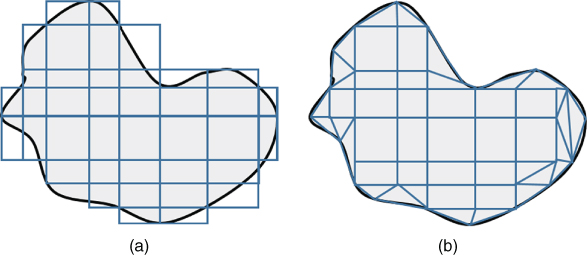6Finite Element Method
6.1 Introduction
Finite element method (FEM) has wide applications in various science and engineering fields viz. structural mechanics, biomechanics and electromagnetic field problems, etc. of which exact solutions may not be determined. The FEM serves as a numerical discretization approach that converts differential equations into algebraic equations. In this regard, the weighted residual methods discussed in Chapter 3 convert governing differential equation to a system of algebraic equations over the entire domain Ω, whereas FEM is applied to finitely discretized elements of the global domain Ω. Also, the finite difference technique discussed in Chapter 5 generally considers the spacing of nodes such that the entire domain is partitioned in terms of squares and rectangles. The FEM overcomes this drawback as depicted in Figure 6.1 by spacing the nodes such that the entire domain is partitioned using any shape in general.

Figure 6.1 (a) Finite difference and (b) finite element discretization of arbitrary object.

Figure 6.2 Nodal points for the domain Ω = [a, b].
In this chapter simple differential equations are solved in order to have better understanding of the finite element technique. There exist various standard books [1–7] and the references mentioned ...
Get Advanced Numerical and Semi-Analytical Methods for Differential Equations now with the O’Reilly learning platform.
O’Reilly members experience books, live events, courses curated by job role, and more from O’Reilly and nearly 200 top publishers.

